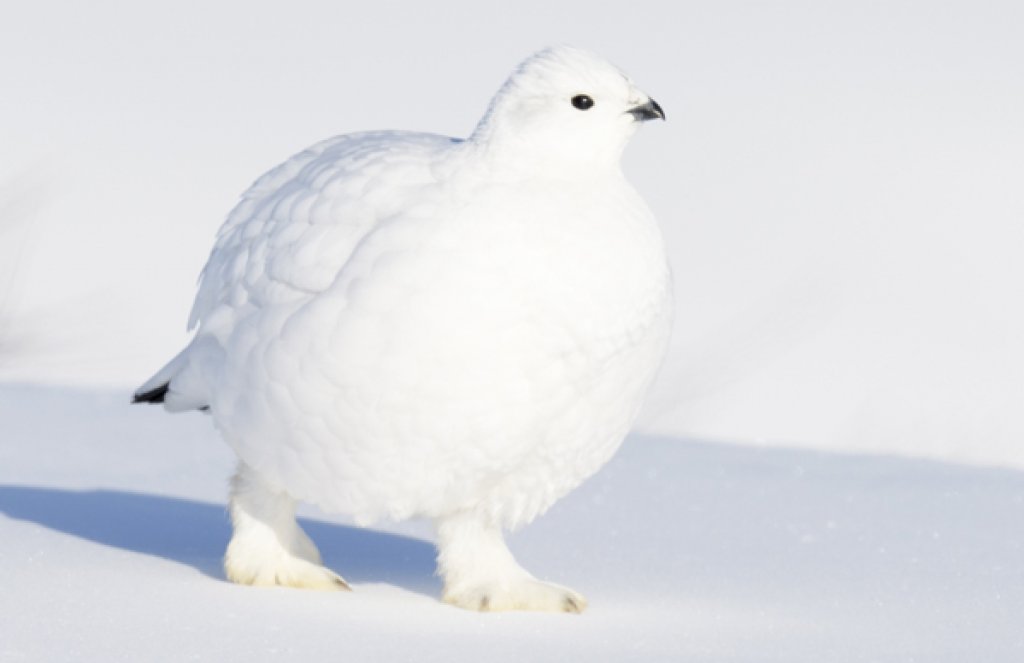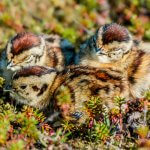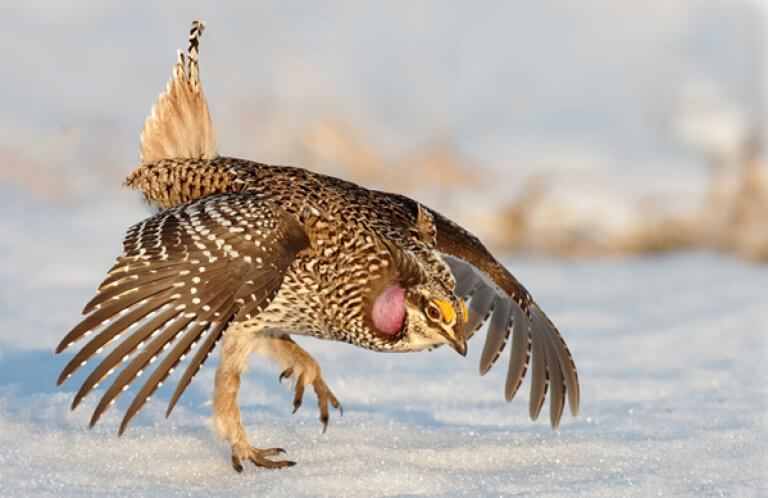About
Although related to other grouse-like birds such as the Northern Bobwhite and Greater Prairie-Chicken, the three tundra-dwelling ptarmigan species are in a genus all their own. The Willow Ptarmigan is the largest. It inhabits alpine and subalpine habitats, where its plumage changes with the seasons to keep the bird effectively camouflaged year-round. During brief Arctic summers, the Willow Ptarmigan's chestnut-, brown-, and gold-mottled feathers make it almost invisible against the flourishing tundra. During this time, bare combs of red skin (which both sexes have but that are often concealed) become prominent in males. In winter, the Willow Ptarmigan molts into pure-white plumage to match its snowy surroundings.
Rabbit Feet and Snowshoe Toes
The Willow Ptarmigan's scientific name, Lagopus lagopus, literally means “rabbit” or “hare foot,” and refers to the almost mammalian appearance of this bird's fully feathered feet. Feather-covered feet help the ptarmigan retain heat during the coldest weather, plus function as snowshoes, allowing the bird to easily move over the snow without sinking. The ptarmigan also gets extra grip on icy footing, thanks to toes that end in sharp, elongated claws.
This hardy bird readily burrows into the snow, both for insulation and for protection from predators while it sleeps.
Songs and Sounds
Croaker Calling
The word ptarmigan derives from the Scottish Gaelic name for the bird, tarmachan, which means “croaker,” referring to this bird's frog-like call. Willow Ptarmigans also make a wide assortment of other strange, low-pitched clucks, rattles, and barking noises, among the least “normal” bird sounds most people are likely to hear.
Listen here:
Breeding and Feeding
Dedicated Dads
Each spring, male Willow Ptarmigans arrive at breeding grounds and claim territories, which they aggressively defend against rivals. When females arrive a few weeks later, males court them, flaring their red eye combs, strutting, and tail-fanning. Unlike lekking relatives such as the Greater Sage-Grouse or Sharp-tailed Grouse, most Willow Ptarmigans form monogamous pairs each breeding season.
When a female Willow Ptarmigan has chosen a mate, she scrapes out a nest on the ground, usually well-hidden among low shrubs at the edge of a clearing. The hen lines her nest with dried grass, leaves, moss, and feathers, then lays a clutch of six to ten eggs. While the female incubates, her mate stays close by to guard her and their eggs. Once the chicks hatch, the male Willow Ptarmigan, unlike many other species in the grouse family, continues to help the female feed, care for, and defend the young. He will even take complete charge of the brood if the female dies.
After the breeding season ends, Willow Ptarmigans become more social. Family groups begin to coalesce into flocks of up to several hundred individuals, and females and young move to lower altitudes to spend the winter in wooded valleys with plenty of food and cover. Male ptarmigans congregate in smaller, separate flocks for the winter, often remaining at higher altitudes.
High-fiber Diet
During the summer, Willow Ptarmigans feast on a variety of plant material: berries, seeds, and the flowering buds and tender young leaves of birches, alders, and willows. In the winter, they consume a more limited diet of twigs, buds, and conifer needles. Ptarmigans are able to subsist on this fibrous fare due to the seasonal enlargement of both their crops and cecums, parts of the digestive system that store and break down tough-to-digest foods.
Newly hatched ptarmigan chicks grow quickly on a high-protein diet of spiders and insects, then switch to plants after their cecums develop enough to digest coarser foods.
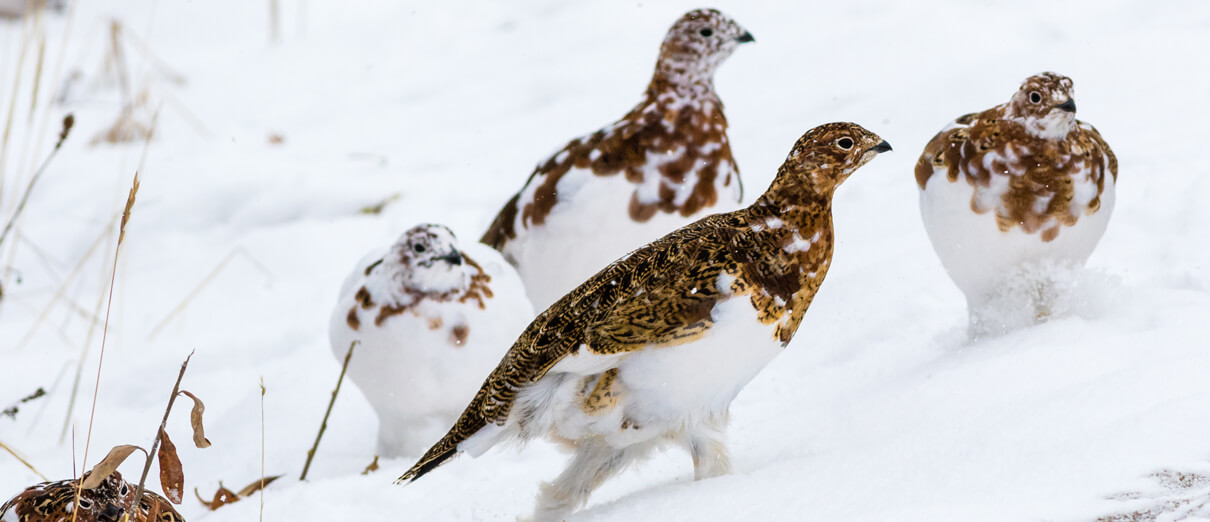
Region and Range
Wide-ranging Willow
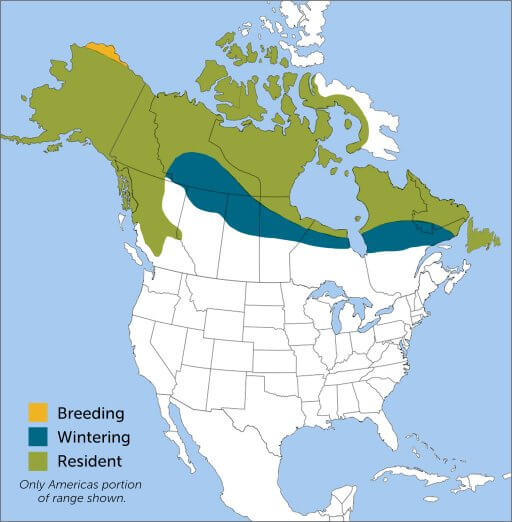
The Willow Ptarmigan occurs in subalpine and subarctic habitats across much of the northern part of the Northen Hemisphere. It is native to Canada and the United States, Scandinavia, the United Kingdom and Ireland, Kazakhstan, Mongolia, and Russia, occurring in pine and birch forests, thickets with willow and alder trees, heather moors, tundra, and on mountain slopes.
This widely distributed ptarmigan has 19 recognized subspecies, six of which are found in North America. One subspecies, the “Red Grouse” of Britain and Ireland, is sometimes considered a separate species; it does not molt into white plumage during the winter and subsists mainly on heather.
Most populations of Willow Ptarmigan migrate short distances between their wintering and breeding ranges. Like many other Arctic species such as the Snowy Owl, Willow Ptarmigans undergo boom-and-bust population cycles, likely tied to weather conditions and the availability of food.
Conservation
Although the Willow Ptarmigan is still numerous and widespread, this species (like most birds) faces threats from habitat loss, particularly where climate change is rapidly changing tundra habitats. Some researchers have noted that prolonged snow-free periods in the spring and fall, which are increasing as the climate warms, throw the timing of the Willow Ptarmigan's seasonal molts out of synch with its surroundings, making the bird an easier target for predators.
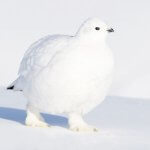
Help support ABC's conservation mission!
ABC is acting in three key areas — mitigation, resilience, and adaptation — to combat the effects of climate change and to help build a sustainable, long-term future for birds. Read more about our efforts to address climate change in our Climate Action Summary.
Get Involved
Policies enacted by the U.S. Congress and federal agencies, such as the U.S. Fish and Wildlife Service, have a huge impact on migratory birds. You can help shape these rules for the better by urging lawmakers to prioritize birds, bird habitat, and bird-friendly measures. To get started, visit ABC's Action Center.
Living a bird-friendly life can have an immediate impact on migratory birds in the United States. Doing so can be as easy as adding native plants to your garden, avoiding pesticides, and keeping cats indoors. To learn more, visit our Bird-Friendly Life page.
American Bird Conservancy and our Migratory Bird Joint Venture partners have improved conservation management on more than 8.5 million acres of U.S. bird habitat — an area larger than the state of Maryland — over the last ten years. That's not all: With the help of international partners, we've established a network of more than 100 areas of priority bird habitat across the Americas, helping to ensure that birds' needs are met during all stages of their lifecycles. These are monumental undertakings, requiring the support of many, and you can help by making a gift today.





































